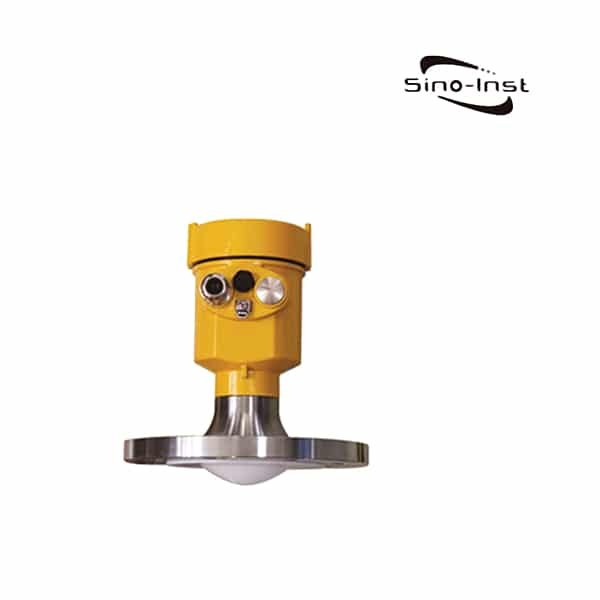Radar Water Level Sensor for Non-contact water level measurement. Two-wire system 4…20mA/HART protocol; four-wire system 4…20mA/RS485 Mod bus. Explosion-proof Exia ⅡC T6 Ga / Exd IIC T6 Gb.

Radar Water Level Sensor for Non-contact water level measurement. SI-FMF13 FMCW Radar Water Level Sensor is the ideal solution for measuring the water level in tank, dams, ponds, rivers, etc. The measuring range is up to 100 meters. IP67waterproof. Frequency modulated continuous wave radar level sensors antenna has been further optimized. The new and fast microprocessor can perform higher rate signal processing.
Sino-Inst offers a variety of FMCW Radar Water Level Sensors for industrial level measurement. If you have any questions, please contact our sales engineers.
Features of SI-FMF13 FMCW Radar Water Level Sensor
- 120GHz (ISM standard band) distance detector based on the working principle of radar.
- FMCW planar microstrip radar non-contact detection. Stable working all-weather.
- The measurement error is less than ±1cm.
- Radar antenna style: 11º×11º. Good directivity, low transmission loss.
- Standard data communication interface (RS-232/RS-485) can be set.
- Low power consumption, waterproof and lightning protection design. Suitable for various outdoor environments.
- Small appearance. Easy to install and easy to maintain.
Specifications of SI-FMF13 FMCW Radar Water Level Sensor
| Measuring medium: | Liquid |
| Measuring range: | 0.1m~100m |
| Process connection: | Flange≥DN80 |
| Process temperature: | -40~110℃ |
| Process pressure: | -0.1~0.3 MPa |
| Accuracy: | ±5mm (range between 35m-100m) ±2mm (range under 35m) |
| Protection level: | IP67 |
| Frequency Range: | 123GHz |
| power supply: | Two-wire system (DC24V)/ four-wire system (DC12V~24V)/four-wire system (AC220V) |
| Explosion-proof grade: | Exia ⅡC T6 Ga / Exd IIC T6 Gb |
| Housing: | Aluminum/plastic/stainless steel |
| Signal output: | Two-wire system 4…20mA/HART protocol Four-wire system 4…20mA/RS485 Mod bus |
Lake Water Level Sensor
Radar water level sensor monitors the water level of rivers, lakes, tidal water reservoirs and reservoirs.
Solution requirements:
The radar water level sensor monitors the water level of rivers, lakes, tidal water reservoirs and reservoirs. It is suitable for installation and use in areas that are not convenient for wiring due to corrosion, pollution, and flood-related water level collection.
Transmit a short microwave pulse, and then measure the elapsed time between pulse transmission and return. The running time of a few meters is measured in units of nanometers. Therefore, a special time conversion program is required to accurately measure these short time periods.
The elapsed time measurement is used to calculate the distance between the sensor and the target (for example, water, grain, slurry). The distance value can then be used to determine the depth of the medium.
Extended reading: Radar Non Contact Water Level Sensor
Technical Support:
Pulse radar level transmitters provide water level measurement based on directly measuring the running time of microwave pulses transmitted to and reflected from the surface of the river being measured. Using rs485 two-wire signal transmission, power supply and low power consumption are safe for outdoor use.
RS485 interface can be connected with 485 line, insert 4g sim card in dtu. 232 to usb to connect to the computer. Open the configuration tool and set the server address and port in the dtu configuration tool.
The server port monitors to receive the data, and it can be analyzed according to the sensor protocol. If the platform is developed to the modbus standard, the sensor also supports modbus. The whole analysis process will be simpler.
Realize remote monitoring and management of liquid level and water level outdoors. Both dtu and sensor industrial-grade outdoor design can be powered by solar energy. Therefore, radar water level gauges can be used in some of the most challenging water level applications.
Advantages:
- dtu rs485 bus access. Multi-device access, support rs232 interface;
- Strong compatibility. Can be connected to five-parameter water quality equipment. Multiple sensors use one gateway;
- Installed on the shore of the water area, on the measuring frame or “extension arm”. Adjust the mounting bracket according to the terrain;
- The installation is simple and the price is low. No need for expensive installation procedures;
- Low power consumption power supply enables the equipment to operate independently in the most remote areas;
- Non-contact measurement principle. Not damaged by silt accumulation or debris;
- Wireless transmission, avoid the trouble of pulling cables. Install and use, remotely unattended;
- High-level industrial requirements for the appearance of the iron shell. Application in hazardous areas and harsh environments;
Extended reading: Capacitive water level sensor
More Water Level Sensors
Sino-Inst offers a variety of water level sensors for a wide range of conditions. Our sensors are ideally suited for monitoring water levels in streams, dams, and reservoirs. Our water level sensor products include:
- Submersible Pressure Transducers
- Radar Level Sensors
- Magnetostrictive Level Sensors
- Pressure Transducers
- Ultrasonic water level sensor
Sino-Inst offers over 10 FMCW Radar Water Level Sensor for level measurement. About 50% of these are float liquid level meters, 40% is the Solid level sensors.
A wide variety of FMCW Radar Water Level Sensor options are available to you, such as free samples, paid samples.
Sino-Inst is a globally recognized supplier and manufacturer of FMCW Radar Water Level Sensor instrumentation, located in China.
Request a Quote
Wu Peng, born in 1980, is a highly respected and accomplished male engineer with extensive experience in the field of automation. With over 20 years of industry experience, Wu has made significant contributions to both academia and engineering projects.
Throughout his career, Wu Peng has participated in numerous national and international engineering projects. Some of his most notable projects include the development of an intelligent control system for oil refineries, the design of a cutting-edge distributed control system for petrochemical plants, and the optimization of control algorithms for natural gas pipelines.